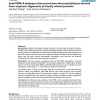42 search results - page 3 / 9 » Domain Identification by Clustering Sequence Alignments |
RECOMB
2006
Springer
16 years 19 days ago
2006
Springer
Homology identification is the first step for many genomic studies. Current methods, based on sequence comparison, can result in a substantial number of mis-assignments due to the ...
95
Voted
IPPS
2006
IEEE
15 years 6 months ago
2006
IEEE
—Homology modeling requires an accurate alignment between a query sequence and its homologs with known three-dimensional (3D) information. Current structural modeling techniques ...
121
click to vote
BIBM
2010
IEEE
14 years 10 months ago
2010
IEEE
16S rRNA gene profiling has recently been boosted by the development of pyrosequencing methods. A common analysis is to group pyrosequences into Operational Taxonomic Units (OTUs),...
BMCBI
2006
15 years 11 days ago
2006
Background: Recognition of relevant sequence deviations can be valuable for elucidating functional differences between protein subfamilies. Interesting residues at highly conserve...
BMCBI
2008
15 years 13 days ago
2008
Background: Insertions and deletions (indels) represent a common type of sequence variations, which are less studied and pose many important biological questions. Recent research ...

